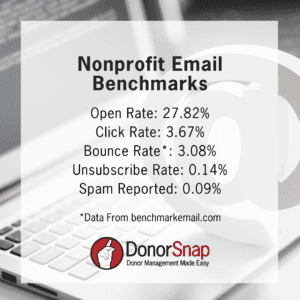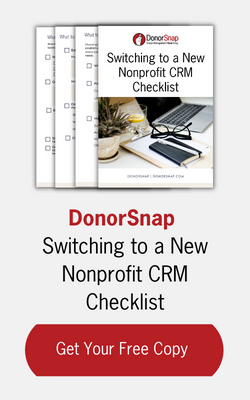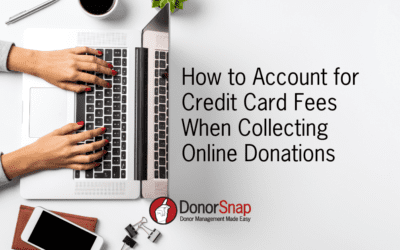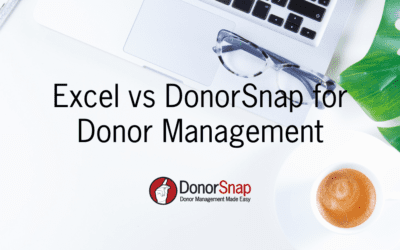Are you looking to get the most out of your nonprofit’s email marketing? Email is the most important communication channel for nonprofits according to Nonprofit Marketing Guide’s 2021 Trends Report. There are a number of things your nonprofit can do to ensure you are effectively reaching your audience though email.
The best practices outlined in this article will help improve engagement and get your message to more people.
#1: Tend to your Mailing Lists
One of the most important aspects of email marketing is taking care of your email lists. When all of your data is in a CRM like DonorSnap, you can easily manage your lists. It is important to only reach out to the people who want to hear from you; through their preferred channels.
In our last blog post, we talked about the importance of donor segmentation. Segmentation is an important aspect of managing your mailing list. You want to be sure you are reaching the right people with the right message.
Some other best practices for managing your mailing lists:
- Only contact people who have subscribed to your mailing list
- Keep your email list clean – high bounce rates will negatively affect your sender reputation and make it harder to get into the inbox of all recipients, for more
- Make a good first impression on new subscribers – you will want to provide them with engaging content off the bat so they don’t unsubscribe
#2: Use a Winning Subject Line

Subject lines are important when it comes to open rates. According to Hubspot, 35% of email recipients open an email based on the subject line alone. Think of your subject line as your first impression, you need to catch the reader’s attention and entice them to open it.
Some best practices when writing an email subject line:
- Create a sense of urgency
- Keep it short and concise. Email subject lines should be less than 50 characters
- Tell them what is inside, open rates will increase when you are clear about what your email contains
#3: Measure and Test your Nonprofit Email Marketing
One of the great things about email marketing is you can easily measure it. You can track the success of a campaign based on open rates, click rates, and the online donations you received. It is important to keep track of these metrics vs. elements of your campaign. Every nonprofit is different and your audience’s preferences will be unique. Testing will help you see which campaigns performed the best so you can continuously improve over time.
Some ideas to test are email subject lines, email design and creative, frequency of emails sent, etc. All of this data lives in DonorSnap so you can easily track your success over time.
#4: Add UTM Tags to Your Campaign
If you have Google Analytics set up, you can use UTM tags to see how well your campaigns performed. They work by adding a tracking code to the end of your links that you put in your email. You can easily create a UTM link on google.
These tracking links allow you to see specific website traffic from a campaign. You can track their journey on your website and easily measure if your campaign was effective.
#5: Know Your Nonprofit Email Marketing Metrics

The last two best practices would not be useful unless you understand your email metrics. It is important to understand open and click-through rates, especially if you want to improve upon them.
DonorSnap’s email system will show you your open rates, click rates, bounce rate, spam reported, and unsubscribes. You can use this data to measure the overall success of your campaign. You first need to understand your industry benchmarks to get an idea of how your metrics hold up.
According to Benchmark Email, the following are benchmarks for nonprofit emails:
- Open Rate: 27.82%
- Click Rate: 3.67%
- Bounce Rate*: 3.08%
- Unsubscribe Rate: 0.14%
- Spam Reported: 0.09%
*Bounce rate on email is how many emails were bad and bounced back, not to be confused with bounce rate on your website analytics.
#6: Have a Clear Call to Action in your Email
People want to know why you are contacting them. A clear call to action tells them the next step. If you send out information without a next step readers may be confused and disengage. You want to keep your organization at the top of their mind, but you also want to direct them to take a particular action. Before you set up a campaign it is important to brainstorm what your goals are. Once you have determined your goals it will help you define what call to action to include in your newsletter.
Some examples of a clear call to action to add to your emails are:
- Save a Life, Donate Now
- Sign the Petition
- Volunteer Today
- Join the Challenge
#7: Always Link to Your Website
Think of email as part of your fundraising ecosystem, but getting users to your website is the ultimate goal. The longer they spend on your website the more likely they are to donate. Your email should entice readers to take action and that action will most likely take place on your website. Whether it is to donate, sign up to volunteer, or sign a petition, the email should direct the reader to your website.
#8: Use Automation
If you haven’t already, check out our blog article Top Four Ways Automation Will Help Your Nonprofit Succeed. Automation is used to send emails based on a specific action your donors take. For example, you may set up your welcome email series as an automated email. That way, when you add a new donor to your database, the system automatically will know to send the email series. This saves you time and keeps your message consistent.
Summary
Adding email to your outreach strategy is essential in today’s fundraising world. It is a low-cost and effective way to reach your supporters and makes it easy to customize your message. Whether you are just getting started or a seasoned email marketing professional, keeping the following best practices in mind when sending emails is important.
Keep your lists clean and organized, use a winning subject line, A/B test your campaigns, add UTM tags to your campaign, know your metrics, have a clear call to action, direct readers to your website, and take advantage of automation. With these tools in your toolkit, you are well on your way to a successful email outreach program.




